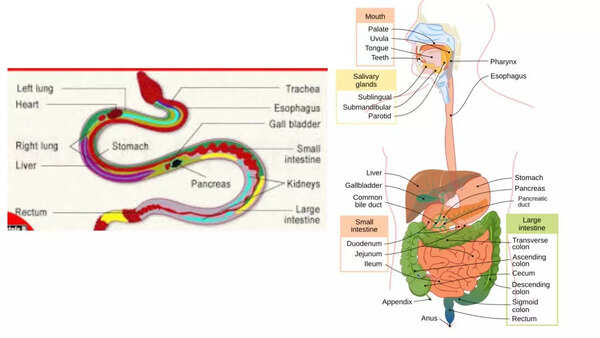
Although both humans and snakes rely on their digestive systems to extract nutrients from food, they differ significantly due to their distinct diets and lifestyles. Among all the key differences, one of the most notable difference is the digestive system of snakes from humans because of the snake’s capacity to swallow and digest large prey whole-a capability made possible by unique anatomical and physiological adaptations whereas, the human digestive system is designed to handle small bite-food items.
Thus, the differences are evident in the structure and function of the esophagus, stomach, intestines and overall digestive system. Discover major differences between humans andsnake digestive system.
Key difference between humans and snakes digestive system
| Feature | Snakes | Humans |
| Teeth Function | Teeth are curved backward to grip prey; no chewing | Teeth used for chewing and breaking down food mechanically |
| Jaw Structure | Flexible jaws that can dislocate to swallow large prey | Rigid jaws; cannot expand or dislocate |
| Swallowing Mechanism | Swallow prey whole; rely on muscular contractions | Swallow chewed food; aided by tongue and throat muscles |
| Saliva | May contain mild venom or digestive enzymes (in some) | Contains enzymes (amylase) to begin carbohydrate digestion |
| Stomach Size and Function | Highly expandable; secretes strong acids and enzymes | Fixed size; secretes acids and enzymes for digestion |
| Digestion Time | Slow; may take days to weeks depending on meal size | Fast; food usually digested within 24–72 hours |
| Metabolic Rate | Low; digestion greatly raises metabolic rate temporarily | High and constant metabolic rate |
| Feeding Frequency | Infrequent; can go weeks or months without eating | Frequent; typically eat multiple times a day |
| Small Intestine | Long and efficient for nutrient absorption | Long, with specialized regions for absorption |
| Large Intestine | Shorter and less developed | Longer; absorbs water and forms feces |
| Waste Elimination | Single cloacal opening for digestive and urinary waste | Separate openings for digestive (anus) and urinary tracts |
| Liver and Pancreas | Function similarly but adapted for infrequent digestion | Regularly active to assist in continuous digestion |

Snakes vs humans digestive system
The digestive system of humans and snakes differ significantly in the structure and function, mainly because of their food habits. Let us look at the main difference:
Teeth function:
Snakes have teeth that are sharp and curved backwards, that are used only to grip and hold the prey.
They do not chew their food and rather prefer to swallow it directly whereas, humans have different types of teeth [incisors, canines, molars] that help them to chew and grind the food into smaller pieces, which is the first part of the digestion process.
Jaw structure:
Snakes possess a highly flexible jaw with ligaments that allow them to dislocate and stretch around the prey, much larger than their head. Humans have a fixed jaw structure that allows vertical movement for chewing but it cannot be expanded beyond a certain limit.
Swallowing mechanism:
The snakes swallow the prey to their stomach because their muscular contractions in the body, known as peristalsis, helps to push the food down to the digestive tract but humans swallow chewed food as their tongue and throat muscles work together to push down the food to the esophagus.
Saliva:
Some species like snakes, have saliva containing mild venom or digestive enzymes to start breaking down the prey but the saliva of humans contain amylase, which is an enzyme that starts breaking down carbohydrates while food is still in the mouth.
Stomach size and function:
Snakes have a highly expandable stomach to accommodate large, whole prey and their stomach secretes powerful acids and enzymes to break down even bones and fur. On the other hand, the stomach of humans has a limited capacity and mainly digests chewed food using acids and enzymes like pepsin.
Digestion time:
It takes several days or even weeks for the snakes to digest their food, especially after large meals as it is a slow and gradual process whereas humans have a typical digestion time of approx 24 to 72 hours, depending on its complexity and size.
Metabolic rate:
Snakes have a low resting metabolic rate but experience a massive spike in metabolism during digestion that is up to 10x or more. Humans maintain a relatively high and steady metabolic rate to support constant body functions and regular meals.
Feeding frequency:
The frequency of snakes to eat is infrequent, which means they may eat a species only once a week or month but humans require regular meals-often three or more times per day to maintain energy and nutrient level in the body.
Small intestine:
Snakes have a long and narrow small intestine that is optimized for extracting nutrients from the whole prey over a long period. Humans also have a small intestine which is long and is specialized for efficient digestion and absorption.
Large intestine:
Snakes have a shorter and less complex large intestine as they extract minimal water from the waste whereas, humans have a larger and more developed large intestine which is crucial for absorbing water and electrolytes and forming solid waste.
Waste elimination:
The opening by which snakes eliminate digestive and urinary waste is called the cloaca but humans use separate exits for digestive waste through anus and urinary waste through urethra.
Liver and pancreas:
In snakes, these organs secrete bile and enzymes, but their function is intermittent, triggered by infrequent meals but in humans, the liver and pancreas are consistently active, supporting near-continuous digestion due to regular habits.Also read: Understanding the surprising truth behind toilet failures on long flights and what it means for passengers

 6 hours ago
30
6 hours ago
30




























 English (US)
English (US)